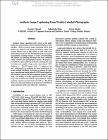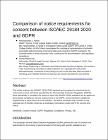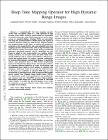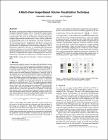Browsing Computer Science by Sponsor "SFI stipend"
Now showing items 1-20 of 31
-
Aesthetic Image Captioning from Weakly-Labelled Photographs
(2019)Aesthetic image captioning (AIC) refers to the multimodal task of generating critical textual feedbacks for photographs. While in natural image captioning (NIC), deep models are trained in an end-to-end manner using ... -
Arbitrary Precision and Low Complexity Micro-Architectural Arithmetic Optimisations of Machine Learning Algorithms for Compute Bound and High-Performance Systems
(Trinity College Dublin. School of Computer Science & Statistics. Discipline of Computer Science, 2021)Artificial intelligence is becoming ubiquitous and pervasive in our daily lives. Machine learning (ML), a subset of Artificial intelligence (AI), supplies more accurate internet searches, voice recognition in home appliances, ... -
Assessing Human-Parity in Machine Translation on the Segment Level
(Association for Computational Linguistics, 2020)Recent machine translation shared tasks have shown top-performing systems to tie or in some cases even outperform human translation. Such conclusions about system and human performance are, however, based on estimates ... -
Collaboration community formation in open systems for agents with multiple goals
(Trinity College Dublin. School of Computer Science & Statistics. Discipline of Computer Science, 2018)Agents frequently coordinate their behaviour and collaborate to achieve a shared goal, share constrained resources, or accomplish a complex task that they cannot do alone. Forming an effective collaboration community in ... -
Comparison of notice requirements for consent between ISO/IEC 29184:2020 and GDPR
(2021)This article analyses the ISO/IEC 29184:2020 standard and compares its requirements for notice and consent with those specified by the General Data Protection Regulation (GDPR). More specifically, it considers the extent ... -
Deep Convolutional Neural Networks for estimating lens distortion parameters
(2019)In this paper we present a convolutional neural network (CNN) to predict multiple lens distortion parameters from a single input image. Unlike other methods, our network is suitable to create high resolution output as ... -
Deep Tone Mapping Operator for High Dynamic Range Images
(2019)A computationally fast tone mapping operator (TMO) that can quickly adapt to a wide spectrum of high dynamic range (HDR) content is quintessential for visualization on varied low dynamic range (LDR) output devices such as ... -
DublinCity: Annotated LiDAR Point Cloud and its Applications
(2019)Scene understanding of full-scale 3D models of an urban area remains a challenging task. While advanced computer vision techniques offer cost-effective approaches to analyse 3D urban elements, a precise and densely ... -
Efficient GPU usage for rendering of Volume Data
(Trinity College Dublin. School of Computer Science & Statistics. Discipline of Computer Science, 2020)Visualising medical images or scientific data that can be shown in 3D poses some interesting challenges. This thesis investigates two distinct areas of Direct Volume Rendering (DVR); time-varying datasets on emerging ... -
Ego-hand Gesture Recognition in Trimmed and Untrimmed Videos for Interactions in Augmented and Virtual Reality.
(Trinity College Dublin. School of Computer Science & Statistics. Discipline of Computer Science, 2021)Hand gestures are used as a way of communication in our daily lives. Using hand gestures to interact with the virtual environment in Augmented and Virtual reality is a natural extension from the real to the virtual scenario. ... -
Enhanced PON Architectures for Converged Access Networks for 5G and Beyond
(Trinity College Dublin. School of Computer Science & Statistics. Discipline of Computer Science, 2022)In the past few years, the existing telecommunication networks are challenged to support the growing number of internet-reliant devices (such as smartphones and other smart devices), increasing penetration of mobile and ... -
The Impact of Training Data Bias on Automatic Generation of Video Captions
(2019)A major issue in machine learning is availability of training data. While this historically referred to the availability of a sufficient volume of training data, recently this has shifted to the availability of sufficient ... -
Improving Document-level Sentiment Analysis with User and Product Context
(Association for Computational Linguistics, 2020)Past work that improves document-level sentiment analysis by encoding user and product information has been limited to considering only the text of the current review. We investigate incorporating additional review text ... -
Improving Robustness Falsification for Medical Device Software
(Trinity College Dublin. School of Computer Science & Statistics. Discipline of Computer Science, 2021)The artificial Pancreas(AP) is a closed-loop system based on the combination of a continuous glucose monitor, a computer-controlled algorithm, and an insulin pump (Blauw et al., 2016). Insulin pumps are designed for ... -
Interactive Light Field Tilt-Shift Refocus with Generalized Shift-and-Sum
(2019)Since their introduction more than two decades ago, light fields have gained considerable interest in graphics and vision communities due to their ability to provide the user with interactive visual content. One of the ... -
L2 based Colour Correction for Light Field Arrays
(2019)In recent years, there has been an increase in the popularity of Light Field (LF) imaging technology with the increase in availability of LF camera devices such as the Lytro, as well as an increase in the use of LF ... -
Low Complexity Multiply-Accumulate Units for Convolutional Neural Networks with Weight-Sharing
(2018)Convolutional neural networks (CNNs) are one of the most successful machine-learning techniques for image, voice, and video processing. CNNs require large amounts of processing capacity and memory bandwidth. Hardware ... -
Modelling Light Field Visual Attention: A Saliency Field Approach
(Trinity College Dublin. School of Computer Science & Statistics. Discipline of Computer Science, 2022)Light field imaging is becoming more accessible, hence understanding how people perceive and interact with it will be of immense value. Although visual attention has been explored for traditional 2D images, we extend this ... -
A Multi-View Image-Based Volume Visualization Technique
(2018)We present an image-based volume visualization approach based on Principal Component Analysis (PCA). Using PCA, a learned model is trained using pre-rendered images from spherically distributed viewing angles. The views ...























